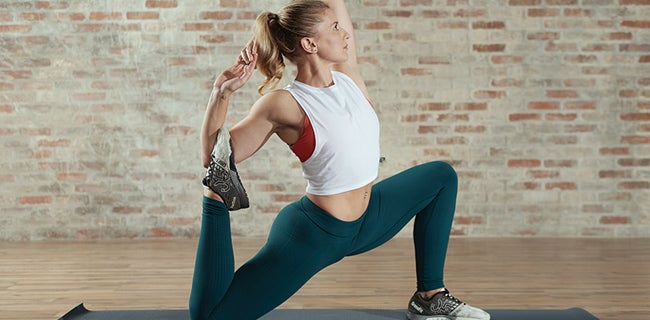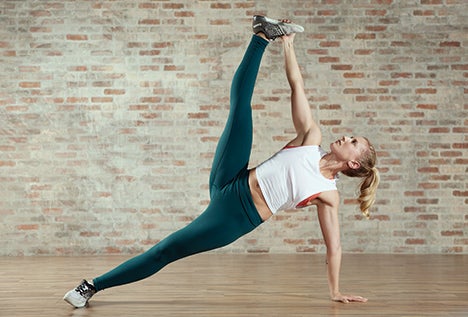Heading out the door? Read this article on the new Outside+ app available now on iOS devices for members! Download the app.

You can’t throw a rock in a grocery store without hitting someone in yoga pants, but though the world has adopted this cling-wear as everyday fashion, not everyone wants to be a bona-fide yogi. In fact, those who have been around the gym a while probably blend with yoga about as well as Donald Trump and Hillary Clinton with one another. But just like gym clothes have been rebranded as “athleisure,” so has the standard yoga practice become an accessible tool that athletes can use to improve performance.
Enter Stephanie (Ring) Main, a yoga instructor in Northern California who created this unique style of yoga to satisfy her own needs. “I started going to yoga in college at a time when I was not doing a lot of sports,” Main says. “I soon realized it was helpful physically and mentally, but I also realized it was not something I could do on its own. I needed strength work and other activities like triathlons, rock climbing and CrossFit, and I realized that yoga could play a supporting role to these other pursuits.”
A relocation from Los Angeles to San Francisco also meant a change in yogic culture for Main, and what was once a very physical practice with lots of tricks became, in her words, about chanting, singing and feelings. “I could not find a place that understood that I didn’t want to get my leg behind my head. That did not help me as an athlete,” Main says. “I wanted a more functional flexibility, flexibility that would help me perform better as an athlete, not take me to a place of extreme mobility.” So where there was a void, Main simply created a style of yoga that fit her lifestyle.
Here’s her take on how yoga can work to your benefit as an athlete, no matter what your sport.
Develops Functional Flexibility
While the goal of many yogis is to effortlessly fold in half, Main steers clear of hypermobility when programming for athletes. “I want balance,” she states simply. “I want to be as strong as possible and as mobile as possible to supplement that strength. Personally, I am not the most flexible yoga teacher you’ll ever see — I can’t get my leg behind my head, and that’s OK. My practice is not about extreme flexibility — it’s about using yoga to improve your performance.”
When doing a move, Main recommends getting into the pose as best you can, modifying it to be easier or harder according to your level, and once you feel the stretch, that’s it. “Once you feel it, stay there,” she says. “That will help prevent overstretching and hyperflexibility. In about 30 seconds, the body begins to accept the stretch and the intensity lowers, and you can slowly get into it a little deeper.”
Try It: Standing Forward Fold
Stand with your feet hip-width apart, legs straight but not locked. Fold forward from your hips and reach your hands toward the floor. Breathe and relax. You should be able to stretch a little farther after 30 seconds or so.
Hone Your Focus
A big component of traditional yoga is breath work, timing your breathing to correlate to different stages in a pose, helping sharpen your mental focus. This mindfulness tenet also can work to your advantage as an athlete. “The reason we get out of position when lifting is focus; our mind goes into the clouds and we forget what we’re doing,” Main says. “Using yoga to help you focus translates to a better, safer performance, improved lifts and faster running times. The more you focus on your breath, the more present you become and the easier it is to feel the things you’re doing. By learning to control it, we can rein in our mind and become more focused on the movement.”
Try It: Breathing Exercise
Take two minutes before starting your warm-up and focus on your breathing. Inhale slowly for a count of two, pause briefly, then exhale for a count of four. As you get into the rhythm, try for deeper, slower breaths, and try to take longer and fewer breaths in minute two than you did in minute one.
Improve Your Warm-Up
Gone are the days of walking dully on a treadmill for five minutes to warm up. Rather, Main recommends 15 to 20 minutes of yoga preworkout for muscle activation and movement prep. “This helps teach your body to get into the positions you’re going to ask it to be in during the workout, like presses and pulls and deadlifts,” she says. “It activates the muscles that need to be working while also exposing weaknesses in your movement patterns.”
A move she uses regularly in warm-ups is the scapular push-up. “This exposes if you are able to move your shoulder blades properly,” she says. “If they are immobile, your overhead and pushing positions will be compromised and other muscles will take over, creating imbalances and improper movement patterns.” The move also acts as a correctional technique, and over time as you practice, you’ll better be able to move your shoulder blades and will improve that weakness.
Try It: Scapular Push-Up
Get into a push-up position with your hands beneath your shoulders and your head, heels and hips aligned. Actively press down into the floor with your palms and spread your shoulder blades apart, rounding slightly through your thoracic spine as you come to the top of your range of motion. Then depress your shoulders into the sockets as you draw your shoulder blades together and return to neutral.
Build a Bulletproof Core
It’s rare to see a yogi with a six-pack, but Main (who sports one herself) insists that yoga can be a killer core workout. “Again, it goes back to stability, and a hyperflexible yogi is not going to be as stable with an overhead lift as an athlete with a solid core,” Main says. “If your core is strong, you will be able to lift heavy overhead or off the ground and run with good posture.”
Main prescribes yoga for core work anytime during your workout — as a warm-up, post-training, even on your active rest days. Her suggestion: Select moves that target your core 360-degrees around, including moves for your six-pack, as well as for your back and sides.
Try It: Hollow Hold
Lie faceup with your arms extended overhead and your legs together along the floor. Brace your core and keep your head neutral as you lift your arms and legs off the floor and make a banana shape with your body. Hold and breathe.
Try It: Superman Lift
Lie facedown with your arms extended overhead, legs straight, head neutral. Exhale and lift your arms and legs as high as you can and hold for 30 seconds. Lower slowly, take a breath and repeat.
To Improve Recovery
In addition to activities such as hiking and easy cycling, yoga can be done on your active rest days to help get blood flowing and give your body some low-intensity muscle activation. “A flow is a good way to get some strength and stability through yoga and is a time when you can slow down and focus on precise movements, which then translate into a more focused workout,” Main says.
She also recommends keeping your sessions short and to the point. “I don’t want you spending hours doing this,” she says frankly. “I want you to spend the hours you have to train in the gym or on the sport you love. This is a supplement to improve your experience as an athlete.”
Try It: Slow Flow
Start in a push-up position. Shift your hips upward toward the ceiling to come into Downward-Facing Dog. Inhale, lift your right leg up as high as you can, then exhale and step your right foot forward between your hands. Inhale and come into a high lunge position with your arms extended overhead. Exhale, place your hands on the floor and step back into plank. Inhale slowly, then exhale and push back into Downward-Facing Dog. Inhale to bring your left foot up, and repeat the sequence on your left side. Go through this flow three times total on each side.

Yoga for You
Want to try Stephanie Main’s brand of athletic yoga for yourself?
You’ll get four hours of exclusive content, including four modules of warm-up and muscle activation for specific bodyparts, four modules of core strength and stability workouts, and five modules of power yoga for strength and body awareness to do on your active rest days.
This program is for all athletes, and you don’t need any equipment or previous yoga experience. All the workouts can be done anywhere, by anyone at any level.
Check it out and start today — you could be on your way to the best lifts of your life.